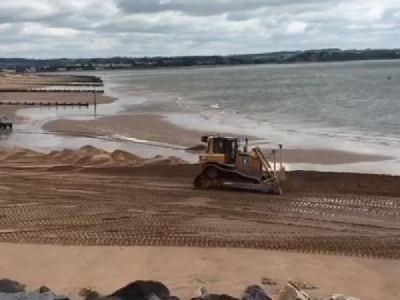
Posted on July 6, 2017
By Daniel Clark, devonlive.com
The equivalent of 50 Olympic swimming pools full of sand have been pumped onto the Dawlish Warren beach as part of a £14million engineering project which is aimed at reducing the risk of flooding to over 2,900 properties.
The scheme involves increasing sand levels at the beach to protect defences through sand replenishment, replacing and refurbishing timber groynes and putting what looks like a giant sandbag into the vulnerable neck section of the Warren.
Around the clock dredging and recharge works at Dawlish Warren has paid off – with the completion of the recharge of the western end of the beach a month ahead of schedule and as a result, the beach now boasts increased sand levels of up to 3 metres in places.
Richard Cox, project manager for the Environment Agency, said: “The good news is we’ve completed the beach recharge at the western end of Dawlish Warren well ahead of our original schedule which tied in with the start of the summer holidays at the end of July.
“This innovative scheme continues to be a balance between enhancing the natural environment whilst performing a flood defence function to protect communities at Dawlish Warren and in the Exe Estuary. Beach goers can now reap the benefit of an improved beach at the western end and once the scheme is complete we’ll have reduced the risk of flooding to more than 2,900 properties around the Exe Estuary.”
Beach replenishment works will continue through the summer, with another 50 Olympic swimming pools worth of sand being placed on the eastern half of the beach. This part of the scheme will be complete by the end of August.
Dredging and beach recharge was specifically programmed between June and August to protect internationally important species of birds and to protect fish movements in the Exe Estuary.
The trailing suction hopper dredger, the Mahury, which has been collecting sand from Pole Sands, just off shore from Dawlish Warren, will stay in situ until beach replenishment is complete.
Cllr Humphrey Clemens, Teignbridge District Council’s executive member for housing and planning which includes coastal services, added: “This is excellent news for residents, traders and visitors, and it is even better news that the recharge work for the main beach has been completed ahead of schedule.
“Credit should go to the teams on the ground carrying out this work: BMM the contractor, alongside staff from Teignbridge and the Environment Agency.
“There’s still work to do with recharge continuing on a section of the beach past groyne six but it’s progressing well. Dawlish Warren beach is looking wonderful and the area will now benefit from a multi-million-pound investment in flood defences that provide a modern standard of protection but also help preserve the beauty of this special place.”
Since work started in January, 1.2km of stone filled gabion baskets have been removed from the Warren. The timber groynes have been refurbished, extended and replaced along the Warren to help hold sand on the beach.
Over 200 new 7 metre long kingposts have been installed to form the new groynes (groynes 10 to 14) and more than 1,500 new planks have been installed to raise the groynes to suit the new beach levels. Construction of a new revetment between groynes 3 and 4 is ongoing but will be complete before the school summer holidays.
Work on the new ‘sandbag’ defence buried deep under the dunes at the narrowest point of the Warren (the Neck) will be ongoing throughout the summer. Giant bags are being pumped full of sand and water which drain to create compacted sand bags up to 2.85m high. When finished, the bags will be buried in the back face of the dune. This structure is designed to reduce flood risk behind from the most severe of storms and prevent the Warren breaching along this vulnerable section.
The estimated economic benefit of the Warren continuing to shelter communities and the main railway line from storms has been calculated at around £158million.
Source: devonlive.com





